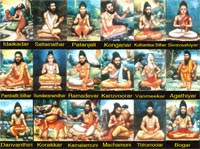As in this series of ‘ancient Tamils and food habits’, so far we have seen about food histories, features, tastes and characteristics and its effect on human beings. However, Siththars gave us the details about: how to take food? when to have food? what are all the foods to be taken? how to treat food as medicine and medicine as food?
Our ancestors strictly followed all the above food habits in their day to day life till the foreign incursion.
Nowadays with the idea of globalization, it is really distressing that we almost forgot all our rooted habits. In this account, I would like to share some of those forgotten conventions in the upcoming posts. Hence, in today’s post, we will see about the how many time we have to intake food on average per day? And also about the time period for food intake..
Siththar Theraaiyar quoted that two meals per day is highly sufficient. His quote is taken from “Pathaartha Kuna Sinthaamani” which is as follows:
தன்மமி ரண்டேயூண் டப்பிமுக்காற் கொள்ளினினன்
thanmami randaeyoon dappimukkaar kollininan
சின்மதலை காளைகடல் சேர்பருவ-தன்மூகுர்த்த
sinmathalai kaalaikadal saerparuva-thanmookurththa
மொன்றுக்கு ணானகுக்கு ளோதுமிரண் டுக்குளுண்பர்
montrukku naanakukku loathumiran dukkulunpar
நன்றுக்குத் தீயோர் நயந்து
nanrukkuth theeyoar nayanthu
Intake of food in two time slot is generally good for health. In addition to this, if anyone wants to have another meals would start their first meal on a day within 1½ hour from sunrise, Then, the second meal within 6 hour from sunrise and final/third meal within 3 hour from sunset time. Violating this food habit is generally bad for health.
மூன்றுநான் காறெண்மு கூர்த்தங் களின்முறையே
moonrunaan kaarenmu koorththang kalinmuraiyae
ஞான்றுளுண்ணு மந்த நறுமுணவே-தோன்றுடலுக்
njaanrulunnu mantha narumunavae –thoanrudaluk
கொக்குமித நோயரமு ரோகமுயிர்க் கந்தரஞ்செய்
kokkumitha noayaramu roakamuyirk kantharanjei
விக்குமித மாராய்ந்து விள்
vikkumitha maraainthu vil
Food will cause slight disease if taken within 4 hours from sunrise. If food taken after 6 hours from sunrise, it will cause diseases. If food taken after 3 hours from sunset, it will lead to deadly diseases.
The above noted view of Siththar Theraiyar should be taken under technical research. However, our ancestors followed the above food habits and lived a healthy life.
Let us see about, how to eat food in upcoming post.
Original – www.siththarkal.com
Translated by Lalithambika Rajasekaran

